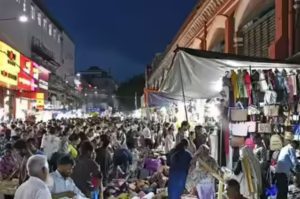Rain Soaked Retail: Kolkata’s vibrant marketplaces are once again shimmering under sheets of blue and black plastic. From the buzzing lanes of New Market and Gariahat to the wholesale heart of Burrabazar and the ever-crowded Hatibagan, makeshift plastic roofs have become a common sight as vendors brace against relentless rain showers. With Durga Puja only weeks away, hawkers are caught between the demands of customers, the threat of damaged goods, and the looming risk of fire accidents.
Monsoon Woes: Shielding Goods at Any Cost
The recent spell of heavy rainfall has left hawkers struggling to save their merchandise. Clothes, cosmetics, food items, and even electronic accessories can be ruined in minutes when sudden showers flood Kolkata’s narrow market lanes. Plastic sheets, cheap and easily available, have become their first line of defense.
At Hatibagan, vendors complain that without plastic, “half the stock would be gone in a single downpour.” Similar concerns echo across Sreemani Market, Bidhan Sarani, and Shyambazar, where goods are often stacked in cartons and kept dangerously close to tangled electric wires.

Yet the choice to use plastic coverings has a darker side: fire hazards. Short circuits are common in congested marketplaces, and with plastic overhead, flames can spread faster than vendors can escape.
A Familiar Cycle: Bans, Raids, and Return
Every monsoon, the city witnesses this same cycle—plastic banned, removed, and then quietly reintroduced. Despite repeated warnings by civic authorities, the practice never really disappears.
The Kolkata Municipal Corporation (KMC) has in the past launched special drives to dismantle plastic coverings, encouraging hawkers to adopt tin shades or regulated canopies. Yet enforcement remains patchy. As one vendor in Burrabazar put it:
“We know it is risky, but if our goods get drenched, who will compensate us? Authorities come and remove the sheets, but within hours, they are back. We have no alternative.”
This tug-of-war between safety regulations and survival is now a yearly phenomenon.
Rain Soaked Retail: The Sreemani Market Concern
One of the starkest examples of this conflict is Sreemani Market, home to over 300 traders. Many shopkeepers not only sell here but also live above the stalls, making it a ticking time bomb in case of fire. Market committees have raised alarms, yet no permanent solution has been implemented.
Experts warn that densely packed, old-style markets in North Kolkata are especially vulnerable, with narrow lanes, poor wiring, and no proper fire exits. Plastic sheets only add another layer of danger.
Consumers Brave Rain and Risk
Ironically, despite the chaos, shoppers are thronging these markets ahead of the festival season. Bargain hunters in Gariahat or New Market often shop under dripping tarpaulins, oblivious to the risks above their heads.
For many middle-class families, these traditional bazaars remain the heart of festive shopping, where prices are negotiable and variety unbeatable. Online retail might be growing, but the cultural pull of Kolkata’s street markets is unmatched.
Enforcement vs. Empathy
Civic officials admit they face an “enforcement dilemma.” Removing plastic sheets entirely would mean exposing vendors’ livelihoods to ruin during the rains. On the other hand, ignoring fire safety hazards could lead to disasters reminiscent of past market fires.
KMC has floated proposals such as installing non-flammable panels that double as advertisement boards. But procurement and implementation are slow, leaving hawkers in limbo.
👉 For urban safety context: NDMA Fire Safety Guidelines
Lessons from Other Market Zones
Some markets have experimented with safer methods:
- On College Street (Boipara), booksellers use raised platforms, bricks, and waterproof tarpaulins to shield their stock from sudden flooding.
- Vendors in South City fringes have pooled funds to build semi-permanent waterproof shades.
- In other cities like Mumbai and Delhi, hawker associations have invested in fire-resistant coverings, often subsidized through local corporations.
Kolkata’s hawkers argue that without financial aid or community solutions, they cannot afford such alternatives.
👉 Comparative insight: Street Vendor Protection Act, 2014
The Way Forward: Balancing Safety and Livelihood
Urban planners and safety experts suggest a three-pronged strategy:
- Affordable Alternatives – Subsidized, fire-resistant coverings for hawkers.
- Civic-Union Collaboration – Joint monitoring to enforce safety without heavy penalties.
- Disaster Preparedness – Vendor training in fire safety, evacuation drills, and basic first aid.
Such measures, they argue, could help break the recurring cycle of plastic use without leaving thousands vulnerable to both rain and fire.
A Symbol of Resilience
At its core, the return of plastic sheets each year is not just about negligence—it is about resilience. Kolkata’s hawkers embody a survival instinct, adapting to hostile weather, limited resources, and bureaucratic hurdles.
As the city gears up for Durga Puja, the clash between rain, commerce, and safety remains unresolved. The blue tarpaulins fluttering over market stalls may seem ordinary, but they tell a deeper story—one of economic struggle, cultural tradition, and the urgent need for sustainable urban solutions.
Until then, Kolkata will continue to shop under sheets of plastic, balancing bargains with unseen risks.
✅ External Resources for Readers:
- Fire & Emergency Services, West Bengal
- National Disaster Management Authority – Fire Safety Guidelines
- Street Vendors (Protection of Livelihood and Regulation of Street Vending) Act, 2014
- India Meteorological Department – Rainfall Updates
Also read: Home | Channel 6 Network – Latest News, Breaking Updates: Politics, Business, Tech & More

